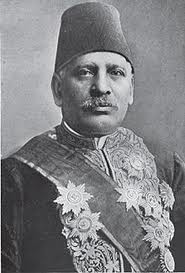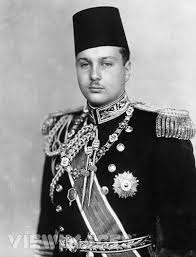The author of this series "Egyptian Frescoes" André Dirlik was born in Egypt and spent the first twenty years of his life in Cairo, then moved to Beirut where he studied at the American University. He later completed his studies at Mc Gill University, in Montreal.
.jpg)
André's long career as professor exclusively at the "Collège Militaire Royal de Saint-Jean" was only interrupted when that institution closed it's doors in 1995.
Egyptian Frescoes (14):
The Six-Day War.
On June
5th, 1967, at dawn, waves of Israeli fighter-bombers
were thrust into the skies of Western Egypt from the Mediterranean Sea. They
had dribbled around Egyptian radars that expected them over Sinai. In barely
thirty seven minutes, the entire Egyptian air fleet that stood, neatly, on the
tarmacs of several military airports was destroyed, an air operation which was
reminiscent of Japan’s total destruction of General Mac Arthur’s Air Force on
the ground in the Philippines. As this very short and surgically executed
operation took place and, during the rest of that fateful day, Egyptian and
Arab radio broadcasts were announcing that the enemy planes were being plucked
out of the skies by Egypt's air defences. Egyptian and Arab masses in the
streets were in a state of delirium. The Road to Jerusalem had finally been
opened as Nasir had promised in one of his firee speeches, on January 29th of
that same year.
It took
the entire day for the truth to emerge. What has since been referred to as the
Six-Day War was, in reality, the Thirty Seven Minute War. Indeed, once the
entire air force of Egypt was sent out of action, neither its armour, its
artillery, its infantry or its navy could fight effectively. It took six days
for the cessation of moping up operations to go into effect. It has taken till
this day for Egyptians and Arabs to overcome the impact of this stunning
defeat. The Six-Day War had announced loud and clear to Arabdom that the
1952 Coup which brought Gamal 'abd il-Nasir to power had proven that he and his
Regime were a failure.
Barely
after this, the shortest war, had been waged, Yusif Shahin, released his latest
movie, al-'Usfur, the Sparrow. Censorship forbade the film to be shown.
Audiences had to wait until 1973, after the victorious crossing by the
Egyptians of the Suez Canal, during the Presidency of Anwar is-Sadat, to see
it. Spectators weep each time they watch the camera hold hands with the script
and the melody and take them through their great expectations and the deep
pains they experienced as a result of their unbearable disappointments. An
entire people's sense of betrayal, its humiliation by a regime that cheated on
them, terrorized them and robbed them of their dreams when it urged them to
stand up in dignity, is narrated in songs which are drawn from the best of
Mahmud Darwish's tradition and from popular Baladi ballads. The message of Shahin
appeals to everyone, the intellectual and the commoner, whose pathos was
scorched. Way and long before the Arab Youth would muster the courage to rise
in anger against its military rulers in an Arab Spring, the cynicism which the
Sparrow brought about in Arab masses forewarned, one can see it four
decades later, of the first rays of a new beginning that appears at the
horizon.
The
Revolution had come to correct the wrongs of yesteryears. The Revolution
promised Social Justice. The Revolution would vindicate the colonial past and
restore the lost pride of the Arab People. The Revolution, also, became
committed to economic development and to raising the standard of living of the
masses. The self proclaimed leader of the Revolution, Colonel Nasir and his
conspirators among the Free Officers, would lead the way for a new Egypt to be
born. The intellectuals supported the Revolution. So did the trade-unions. The
peasantry acclaimed the Land Reform. Nasir, who was proving to be a formidable
communicator, saw his star rise rapidly in the national and world arenas.
 |
| Gamal Abdel Nasser |
 The
Egyptian Revolution had been intent on bringing about fundamental changes to
the country and such changes did occur. Demographically, for one, infant
mortality which had been estimated at 200 per 1000 in 1950 dropped to 50 as a
result of improved hygiene and diet. The revolution opened dispensaries in the
villages. It also increased the number of schools. As the population exploded
in numbers, the trend towards urbanization followed at a critical pace. This
measure by the government illustrates how policies were adopted haphazardly by
incompetent policy makers who had not anticipated the slums that would mushroom
around the cities as a result of overpopulation in the countryside. This
haphazardness became the trade mark of the Regime which embarked upon worthy
projects which proved, in the end, ill thought and poorly carried out. At the
end of the day, when Nasir closed the Straits of Tiran to Israeli shipping, on
the 23rd of May, 1967, he did so while a major part of his Army was bogged down
in Yaman, supporting a revolution. On the 5th of June, his air force was
destroyed by Israel in retaliation. Between April 18 and 24, 1955, Nasir was
invited at a Conference of Non-Aligned Nations in Bandung, Indonesia. He was
received by President Sukarno and welcomed by PM Nehru of India, President Tito
of Yugoslavia and PM Chu en-Lai of China, three major players on the world
scene, as the sole representative of 150 million Arabs who stretched from
Morocco to Iraq. This was the time when the Cold War was raging between the
United States of America and the Soviet Union. Nasir's Egypt had gotten
entangled in that cold war at great cost to itself. Historians will one day
trace the true reasons for this entanglement. At face value, it appears as
though Nasir's rashness, his inner anger and his arrogance led him onto the
slippery path that caused the 1956 Tri-Partite Aggression against Egypt and
brought him into the Soviet fold. It shall have taken the sudden death of its
leader, in 1971, for Egyptians to disentangle themselves from a game of nations
they proved they could not successfully play.
The
Egyptian Revolution had been intent on bringing about fundamental changes to
the country and such changes did occur. Demographically, for one, infant
mortality which had been estimated at 200 per 1000 in 1950 dropped to 50 as a
result of improved hygiene and diet. The revolution opened dispensaries in the
villages. It also increased the number of schools. As the population exploded
in numbers, the trend towards urbanization followed at a critical pace. This
measure by the government illustrates how policies were adopted haphazardly by
incompetent policy makers who had not anticipated the slums that would mushroom
around the cities as a result of overpopulation in the countryside. This
haphazardness became the trade mark of the Regime which embarked upon worthy
projects which proved, in the end, ill thought and poorly carried out. At the
end of the day, when Nasir closed the Straits of Tiran to Israeli shipping, on
the 23rd of May, 1967, he did so while a major part of his Army was bogged down
in Yaman, supporting a revolution. On the 5th of June, his air force was
destroyed by Israel in retaliation. Between April 18 and 24, 1955, Nasir was
invited at a Conference of Non-Aligned Nations in Bandung, Indonesia. He was
received by President Sukarno and welcomed by PM Nehru of India, President Tito
of Yugoslavia and PM Chu en-Lai of China, three major players on the world
scene, as the sole representative of 150 million Arabs who stretched from
Morocco to Iraq. This was the time when the Cold War was raging between the
United States of America and the Soviet Union. Nasir's Egypt had gotten
entangled in that cold war at great cost to itself. Historians will one day
trace the true reasons for this entanglement. At face value, it appears as
though Nasir's rashness, his inner anger and his arrogance led him onto the
slippery path that caused the 1956 Tri-Partite Aggression against Egypt and
brought him into the Soviet fold. It shall have taken the sudden death of its
leader, in 1971, for Egyptians to disentangle themselves from a game of nations
they proved they could not successfully play. |
| Bandung Conference |
Nasir
was neglecting Egypt for the sake of his adventurist foreign policy. Israel
rehearsed in 1956 the War of 1967 while the Egyptian Regime deluded itself by
making believe it had defeated three powers on its own. The regime, also, toyed
with an ideology which combined Arabism and Socialism. Its ideological vagaries
were inducing its residents, especially the Khawagat, to consider leaving and
some began to depart. As a result of the 1956 War, Jews, French and British
citizens and businesses were expelled. And, in 1961, like a mother that turns
against her own children, the State started nationalizing Egyptian owned
enterprises, including the Misr Group initiated by Tal'at Harb. The country had
grown impoverished and out of breath. Egypt's charismatic leader whom all had
expected to perform miracles could not anymore. When his sudden death was
announced on September 28th, 1970, many commentators explained popular hysteria
as a proof that his popularity had not waned. True, the loss of his charisma,
for the leader, is often expressed by anger on the part of his followers who
turn against him; it may also be expressed by a sense of loss and
despair.
Many
will consider the appraisal of the Nasir years harsh on my part and I admit
they are. Unless one understands that Nasir was the child of his epoch. His
vindictiveness, reflected in his petty actions and in some of his speeches,
strip him of the title of a wise and great statesman. His police helped
buttress his own insecurities.
His appointment of 'abd al Hakim 'Amir as his
Commander-in-Chief denotes his preference for loyalty rather than competence.
And yet competence amongst Egyptians there was who were eager to serve uplift
their country. These competent Egyptians were, instead, pushed aside by a class
conscious leadership which seemed to want to get even with those they had long
envied. The Regime preferred to humiliate rather than utilize the many who were
the result of several generations of reforms which Muhammad 'Ali Basha had
initiated.
 |
| Abdel Hakim Amer |
Let us,
for fun's sake, next play the What If game. The aim of the game is not to make
one cry over spilt milk but rather to speculate if, indeed, there were avenues
that could otherwise have been borrowed and mistakes that could have been
avoided. A footnote to What If should be a reminder that Major Kamal id-Din
Husayn, a prominent member of the Free Officers, addressed a meeting of Egypt's
intelligentsia, early on after 1952. Attendants were offering points of views
and advice to the new powers that be. The Major responded that it was the
officer corps that had become today's intellectuals. The new intellectuals he
pretentiously referred to were devoid of any skills in determining costs and
benefits of their acts. In 1967, barely a decade later, incompetence led to the
threshold of the Thirty Seven Minutes Debacle.























